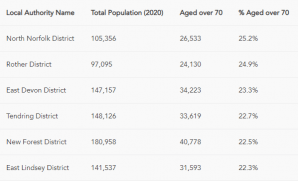Data & intelligence: An essential tool for the public sector in these unprecedented times
As we move into the ‘delay’ phase of the Government’s action plan to tackle the Coronavirus outbreak, those who work for organisations that have implemented appropriate business continuity plans will be working from home to keep ‘business as usual’.
This is clearly great for those who can work in this way, however what can be done to support businesses (and their employees) who operate in sectors who are directly affected by the significant changes imposed on our everyday lives? Although the Government’s plans are still evolving, the Chancellor’s package of financial support available to business during this period have been widely welcomed.
But what about low income renters or at risk and vulnerable community groups such as the over seventies, those with underlying health conditions or those who already feel socially isolated? As these groups are likely to face the biggest challenge during this difficult period, who is responsible for their wellbeing and what provisions will be made to ensure they are supported throughout?
Given that the Government has said that Councils will be fully funded for coronavirus costs, it is highly likely that local authorities alongside their colleagues in public health and the wider integrated care system will be on hand to support these community groups. But what does the public sector know about who they are, where they are and how to reach them?
The increasing role of data and intelligence in resource planning and targeting
Data and intelligence is already an essential tool for the public sector to help understand the demographic, lifestyle, behavioural and health characteristics of residents when prioritising and delivering services. Over the coming weeks and months data and intelligence will increasingly play an integral part of resource planning and targeting as the true impact of social distancing is felt by us all, particularly those who will feel the affect of social isolation more.
The use of data is also supported by the Secretary of State for Health and Social Care, Matt Hancock who tweeted “Public information: GDPR does not inhibit use of data for coronavirus response. GDPR has a clause excepting work in the overwhelming public interest. No one should constrain work on responding to coronavirus due to data protection laws.”
This is further supported by the news that US Government officials are currently in discussion with a number of tech companies, including Facebook and Google, around how data from cell phones might provide methods for combating the ongoing coronavirus pandemic.
The Government has already published guidance on social distancing for everyone in the UK, particularly older people and vulnerable adults. But what can data and intelligence really tell us about these groups and how can this be used to assist with meaningful action?
Using data to understand the impact, and the affect on services
Data will allow you to understand the likely numbers involved, assess the impact of the measures so that you can see just how much this will affect services. For example, according to CACI’s current population estimates the UK population is currently just over 67 million and of that 13.7% are aged over 70. That means the Government is asking some 9 million people to self-isolate regardless of their medical conditions. In addition, analysis has shown that the largest proportion of the population aged over 70 can be found in rural authorities rather than those covering urban areas.
Top six local authorities by percentage of population over 70

If we specifically look at those who are aged seventy or over with diabetes and living alone, the health and wellbeing characteristics (Wellbeing Acorn) of these people indicate that they are three times more likely to have the biggest health challenges in the UK. They are also likely to be taking four or more prescribed medicines with many treating issues concerning cardio-vascular, gastrointestinal, the central nervous system and the endocrine system. Incidence of smoking is high with spending on tobacco at almost 70% above average resulting in higher rates of breathlessness, asthma and cancer. Their increased exposure to the health services means they are more likely to engage with multiple NHS departments. Furthermore, many of these people live in deprived neighbourhoods containing many social renting pensioners in high rise flats. They are also members of local residents or social groups and they like to talk to their neighbours. Despite this, they are more than twice the national average not have someone who will listen nor anyone who can help in a crisis.
This intelligence is key to understanding the needs of these vulnerable and at-risk groups, assessing the demand and subsequent impact they may have on services as well as identify ways in which public services may be able to communicate and engage with them during this period of isolation.


